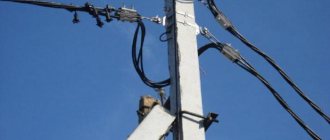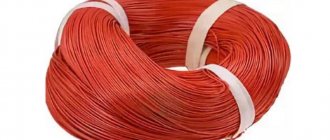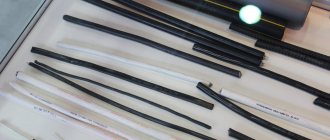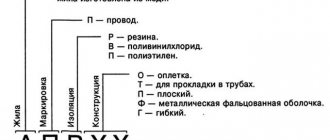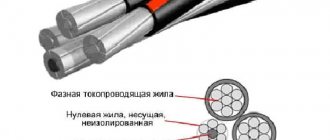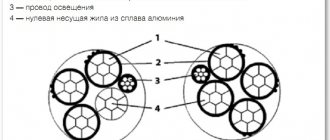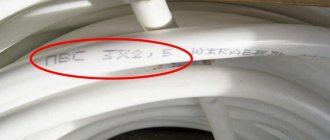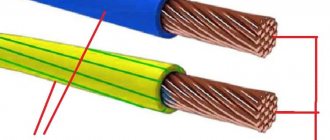To transmit electrical energy through power and lighting overhead lines, a self-supporting insulated wire (SIP) is used. Lines using this type of cable were invented in the 60s by Finnish engineers as an alternative to using bare wires that were suspended on cables. This method of energy transmission ensures minimal losses and is suitable for installation on existing power transmission poles.
What is SIP wire
To understand the purpose and design of the cable, you first need to decipher the markings:
- C – self-supporting;
- I – isolated;
- P – wire.
This cable is used for laying electrical transmission lines over the air. This is an ideal option when installation is carried out according to the “pole to house” system. On the other hand, the conductor cannot be led directly into the house or living quarters, since the insulation is not intended for such use. As a result, the SIP is extended to the distribution panel, which is the input node and is located on the street. An electric meter and an automatic input device are placed inside it. Other cables are laid from the panel into the house, usually with copper conductors and good insulation. Their diameter is much smaller and their flexibility is higher.
Structurally, a wire differs from a cable in the absence of insulation, which is why our product is called “self-supporting insulated wire.” There is no additional protection in the form of an outer shell or armor, and only the conductors are insulated. Thus, technically calling it a SIP cable is incorrect.
The adjective “self-supporting” indicates that for overhead lines there is no need to use a dielectric cable to which the remaining wires are attached. SIP of any brand is characterized by a high load-bearing capacity, which is sufficient for the cable to withstand its own weight and additional loads due to wind or precipitation (for example, snow settling on power lines).
Possible installation errors
When installing an input into a house using a SIP cable, difficulties may arise, and in order to avoid mistakes, the most common of them are listed below:
- Weak tension: a dynamometer was not used when tensioning, and installation was carried out “by eye.” This error can lead to increased load on the cable, especially in winter, and its breakage.
- Strong tension: also has a negative effect on the cable, especially its insulation.
- An attempt to reuse piercing clamps: they are disposable, since the head breaks off and re-installation is not possible.
- Damage to insulation during work: It is important to use a solid cable; damage to the insulation may result in a short circuit or electric shock.
- The clamps are not fully secured: the conductors must be correctly and securely fixed in the clamps and not dangle in them. A bad clamp will lead to poor contact, sparking and cable damage.
Design and composition
Structurally, SIP consists of aluminum cores twisted together and protected by a durable layer of polyethylene. The conductors are light-stabilizing, therefore, when exposed to ultraviolet rays, their technical and operational characteristics do not change.
The shell of individual conductors in SIP is black. The cable includes a load-bearing element connected to the zero. The rest of the wires are wound around it.
In general, SIP consists of the following components:
- current-carrying conductors;
- steel wire core;
- high-strength polyethylene shell.
The SIP-3 power cable is made of aluminum conductors and a steel core with a round cross-section. The number of cores is formed in accordance with the standards of specifications individually for the selected brand. The design of SIP may imply the use of a self-supporting aluminum core; in SIP-3, SIP-4 and SIP-5 it is absent.
Important! The quality of the SIP can be judged by how the phase wire is twisted. It always moves clockwise relative to zero.
In the electric cable SIP-2, SIP-3 or SIP-5, the sheath is made of cross-linked XLPE, which increases light stabilization. In SIP-1 and SIP-4 it is made from thermoplastic polyethylene (LDPE).
The technical parameters of the product depend on its design features. One or two capital letters placed in brackets can be added to the abbreviation SIP:
- SIP (N) – the shell of the conductors is made from materials that are resistant to combustion.
- SIP (G) - insulation protects the wire structure from exposure to water or moisture.
- SIP (NG) - cross-linked polyethylene is used for the shell, resistant to both combustion and moisture penetration.
Types and purpose of SIP wires
SIP wire is the best option for running power lines to a private home. This is an inexpensive product with good technical and operational characteristics, which is available in three varieties:
- exposed carrier neutral;
- isolated carrier neutral;
- self-supporting cable.
The main material for the manufacture of current-carrying cores and supporting conductors is aluminum. In the latter case, an alloy with high load-bearing capacity is used. Let's look at the main types of SIP.
Wire SIP-1
In this case, the wire is manufactured with a bare carrier neutral in accordance with the European standard. Structurally, SIP-1 is one load-bearing bare wire made of pure aluminum or a reinforced alloy, around which one to four current-carrying conductors with LDPE insulation are twisted. The latter material protects the product from ultraviolet rays.
This wire is used during the installation of main electrical transmission lines and various branches, provided there is dry or normal air with a minimum amount of dust. Suitable for electrical networks with a total voltage of 600 or 1000 V at a frequency of 50 Hz.
All conductors, protected by insulation, are twisted around the supporting wire with a certain pitch. An individual core may consist of one or more wires. The neutral core is made from a high-quality core. Steel or aluminum can be used. Round aluminum conductors are placed around the core. The diameter of the supporting core is much larger.
After laying the SIP, the weight of the entire structure is restrained by the load-bearing core installed on guy wires, attached to poles, etc. This is associated with an increase in thickness relative to other current-carrying conductors. In most cases, the thickened core is zero. The remaining cores are necessarily insulated with thermoplastic polyethylene, capable of withstanding air temperatures up to 70 degrees. Celsius with continuous heating or up to 125 degrees. Celsius at short-term. Also, the power line at SIP-1 will withstand heavy snow loads.
The main disadvantage of using SIP-1 is that when a phase imbalance occurs, a high and life-threatening voltage may appear on the exposed supporting wire. To prevent this, the neutral at each pole is grounded. But even if there is such a possibility, it is not recommended to lay street cable along the facade of the building.
Wires SIP-2 and SIP-3
Wires of brands SIP-2 and SIP-3 have an insulated neutral. The supporting neutral wire, unlike SIP-1, is protected by a high-quality sheath, while the remaining structural elements remain unchanged: one to four current-carrying conductors are twisted around the thickened neutral, insulated with cross-linked polyethylene with high light-stabilizing properties.
Operation of SIP-2 is permissible in electrical networks with a voltage of 600 or 1000 V. Unlike SIP-1, the second category can be used in conditions of high humidity and high salt content in the air (for example, on the coast of seas and oceans, near salt marshes, etc. .). The wire can also be fixed directly to the walls of residential buildings. This is an ideal solution when laying lines from a pole to a house.
SIP-3 is identical in structure to the cable of the second category, but is characterized by a thicker sheath. Thanks to this, the prefix “protected” is added to the description of the wire. Operation is permissible in networks with a much higher rated voltage - up to 20 or 35 kV, depending on the specific product model. As for technical characteristics, the cable is identical to SIP-1, although differences can be found when comparing permissible current loads.
SIPs of the second and third categories are suspended on a supporting conductor of increased diameter. Since it is insulated, possible current induction is eliminated. However, there is a risk of shell rupture due to excessively high mechanical stress. Thus, when designing a power transmission line on SIP-2, installers try to reduce the span (the distance between the nearest poles) to a minimum.
Wire SIP-4, SIP-5 and SIP-7
In design, all three categories of wires differ significantly from those listed above:
- the product does not have a supporting conductor, so the load is immediately placed on all current-carrying conductors;
- the strength of the cable is much lower than SIP-1, SIP-2 and SIP-3, which is precisely due to the lack of a support wire;
- they cannot be used in regions with large amounts of precipitation in the form of snow or frequent icing.
It is also worth noting that the wire can consist of two, three or four conductors (there are no single-core SIPs of the fourth, fifth or seventh categories). One or two wires for lighting can be added to the product. The veins twist together to form a common center. The twist pitch depends on the specific model. One core is made zero, all the rest are made phase.
SIP-4 is used in electrical networks with a voltage of 600 or 1000 V. Since the design does not imply the use of a thickened load-bearing core, the cable is characterized by increased flexibility, and the minimum bending radius is 7.5 radii of the total diameter.
This is the most popular SIP wire, due to its reduced cost and good technical parameters. There are several additional types of SIP of the fourth category:
- SIPn-4 is manufactured with high-quality insulation that does not support combustion.
- SIPsn-4 has non-flammable insulation and one or two lighting conductors. It can also be upgraded with one to three copper conductors for control circuits. In this case, numbers are added to the abbreviation through a “plus” indicating the number of these auxiliary conductors.
- The SIPgsn-4 cable differs from the previous version in that it can additionally prevent moisture from entering.
The last two types of wire have a European analogue called AsXSn. The purpose and most technical and operational characteristics of these products are identical.
The next category - SIP-5 - differs from the previous one in that it is not possible to turn on auxiliary conductors for signaling or lighting. The product contains current-carrying conductors of identical diameters. The total number of conductors is from two to four: as always, one of them is neutral, the rest are phase.
Single-core wire SIP-7 is produced with reinforced insulation, consisting of several layers:
- screen made of electrically conductive polyethylene;
- cross-linked polyethylene;
- weather-resistant polyethylene.
This cable can be used in electrical networks whose voltage reaches 110 kV. An excellent option in cases where it is not possible to carry out underground electrical installations, and the use of bare conductors is unacceptable. The most striking example is park areas and other high-traffic areas. SIP-7 is suitable for use in temperate, cold or tropical climates. Less common is copper insulated cable SIP-7.
Types of SIP cable
Wires are divided into 4 main types.
- SIP-1 and SIP-2 are applicable both for main overhead power lines and their branches, designed for a voltage of 0.6-1 kV. The load-bearing core in SIP-1 is uninsulated, unlike SIP-2.
- In SIP-3, the cores are made of aluminum alloy with insulation made of extruded polymers. Such wires are used for overhead power lines, where the rated voltage is 10, 20 or 35 kV.
- In SIP-4 there is no load-bearing conductor, therefore this type is used exclusively for linear branches of air mains and is laid along the surface of the walls of buildings and structures.
For regions with high humidity, special sealed wires are produced, correspondingly marked with the letter “g”. For them, GOST establishes requirements for resistance to the longitudinal spread of water. This indicator should not exceed 3 m along the wire from the point of its penetration.
Most manufacturers provide a 3-4 year warranty on self-supporting wires, and their service life must be at least 40 years.
Advantages and disadvantages
Let us list the main advantages of SIP wires:
- Easy to install and lay. The process takes less effort and time compared to installing other bare wires. There is no need to attach the conductors to insulators.
- Reducing the likelihood of unauthorized connection to the line. Switching requires certain skills and work experience, so not everyone can perform such actions.
- SIP insulating shells are made from high-quality material that repels wet snow and condensation, which eliminates serious icing of the line. If ice appears, it is in small quantities.
- Reducing the likelihood of electric shock. The presence of conductor insulation reduces the risk of electric shock during repair work and maintenance of power lines. Many operations can be performed without turning off the voltage.
- Economical. Due to the SIP design, the wire is less susceptible to breakage. Minimal funds are spent on maintenance; the wire can be installed on the facades of residential buildings (with the exception of some categories), thereby reducing the number of installed supports.
- Reduced inductance. Due to the low reactance in the wire, the amount of power and voltage losses is significantly less. This eliminates the formation of current pickups and allows you to mount self-supporting insulated insulated wires on supports for low-voltage lines.
The disadvantages include:
- High cost compared to simple bare wires. For quite objective reasons, the price of SIP is significantly higher than the cost of conventional non-insulated cables.
- When using SIP, you must contact qualified specialists. Only they can perform high-quality installation and maintenance of power lines using these wires. This is due to the fact that such products appeared relatively recently, so they have not yet become so widespread. Add to all this the fact that domestic electrical supply systems are not suitable for the transition to self-supporting insulated conductors.
Accessories for cable installation
SIP wire components are nothing more than mounting hardware. It is used on the facades of any buildings, wooden and reinforced concrete pillars. The fittings allow you to connect the cores to each other. For example, piercing clamps are very convenient, which do not need to be insulated, and when connecting to a similar cable, it is not necessary to cut off the insulation from its core.
Anchors, clamps, hooks - these are all fittings that allow you to hang cables on supports and building facades. To adjust the sag arms or when connecting the line to a building, electricians use a special tensioner. In addition, various clamps, limiters and other components are used to help with the installation of VLI. All fittings are characterized by anti-corrosion resistance, are not afraid of exposure to UV rays, are easy to install, providing a reliable and tight connection.
According to GOST 31946-2012, the insulation of phase conductors must contain color markings, displayed by longitudinal lines applied by pressing or printed numbers. It is allowed to apply numbers using the embossing method. The zero core does not have any markings. It is also allowed to apply colored stripes to the phase conductors that stand out against a black background. If the cable has additional cores used for lighting, they are marked “B1”, “B2” or “B3”. Insulation markings are applied every 500 mm.
Selecting a section and checking the product
When going to the store to purchase a self-supporting insulated wire, pay attention to the rated current. To calculate the required value, a diagram is formed that takes into account the length of the power network sections and the load on each of them.
After you calculate the approximate current value, compare it with the one indicated in the table below to select the SIP brand and cross-sectional size. Table of SIP cross-sections depending on permissible currents:
| Core cross-section, sq. mm | Permissible current for LPDE insulation | Permissible current for XLPE insulation |
| 16 | 70 | 100 |
| 25 | 95 | 130 |
| 35 | 115 | 160 |
| 50 | 140 | 195 |
| 70 | 180 | 240 |
| 95 | 220 | 290 |
| 120 | 250 | 340 |
For example, if the calculated current is 110 A, then you need to purchase SIP-1 with a cross-section of 35 square meters. mm or SIP-2 with a cross section of 25 sq. mm. The latter option is preferable, since such a wire will be lighter, stronger and more protected from wind and precipitation.
Advice! When choosing SIP, try to buy a wire with current-carrying conductors of a larger diameter than required according to the calculation. This will cover any load increases that occur in the future.
Before installing the wire, make sure that all wires are intact. To do this, use a multimeter:
- Switch the toggle switch to the “Test” position of the resistance sector, then connect the red and black probes to each other. If the device is working properly, you will hear a signal indicating that the dialing mode is activated.
- Using two probes, touch both ends of the SIP wire. If there is no damage to the conductor, you will hear a beep indicating that the charge has passed from one end to the other.
- These steps will need to be repeated for each core.
Similar checks should be carried out for a toggle switch installed in the resistance measurement sector from 200 Ohm to 200 kOhm. If the display shows “0”, then the conductor is intact, “1” - there is a break in the line.
Manufacturers and cost of SIP cables
There are a huge number of factories and small manufacturers producing various brands of SIP cable. The companies listed below mostly produce high-quality products in accordance with the stated requirements:
- Kamsky Kabel LLC;
- LLC "GK Sevkabel";
- JSC "Moskabel Plant"
The cost of the product depends on the specific manufacturer and category of wire. For example, SIP-1 can be purchased on average for 20, SIP-2 – 25, SIP-3 – 60, SIP-4 – 100 rubles/p. m. The indicated prices may vary depending on the selected region of our country.
Specifications
The cross-section of the conductors of SIP wires ranges from 16 to 185 mm2, is capable of powering powerful consumers and passing currents up to 500 A, and permissible currents of one-second short circuits can reach 16 kA. There is a large selection of cable options in terms of cross-sectional dimensions and permissible current, so this wire is universal for constructing overhead lines.
The operating temperature ranges from -60 to +50 °C, and the cable design can be for both moderate and cold climates. Installation of SIP wire is possible at temperatures down to -20 °C.
The service life reaches 45 years and most manufacturers provide a warranty of up to 5 years.
Such a cable is subject to mechanical loads from wind, ice, and snow, so such lines must be calculated based on their weight and the effect of mechanical loads on them. For this calculation, data on the destructive force of the supporting cable are used, depending on the type, cross-section and mass of the wire.
Packaging, storage and transportation of SIP products
In accordance with GOST, self-supporting insulated wire is supplied in drums. The product can only be transported in them. Sometimes transportation with subsequent storage in bays is possible. In this case, two conditions must be met: the cross-section of the core must be 16-25 square meters. mm, the total weight of the coil is up to 25 kg. When storing, use sheds or closed areas. Short-term outdoor accommodation is possible.
According to standards, the outer surface of the drums must be protected with special mats. An accompanying document in the form of a label or technical passport must be added to the product. It is attached to the drum cheek or bay. To prevent the label or passport from getting lost, it should be placed inside a moisture-proof package.
Thus, the SIP wire discussed in the article has practically no disadvantages. If you find a qualified installer, regardless of the slightly inflated cost, then there will be no disadvantages at all. Keep in mind that the costs will soon pay for themselves due to the absence of voltage and power losses, protection against unauthorized switching leading to the theft of electrical energy, and savings in the maintenance of power lines.
